Which of the following structures sets the pace of heart contraction?
atrioventricular bundle
SA node
bundle branches
AV node
SA node
The layers of the heart wall from superficial to deep are: __________.
epicardium, endocardium, and myocardium
epicardium, myocardium, and endocardium
myocardium, endocardium, and epicardium
endocardium, myocardium, and epicardium
epicardium, myocardium, and endocardium
Which of the following would increase heart rate?
cold temperature
low metabolic rate
epinephrine
parasympathetic stimulation
Epinephrine
The P wave of a normal electrocardiogram indicates ________.
ventricular repolarization
ventricular depolarization
atrial repolarization
atrial depolarization
Atrial depolarization
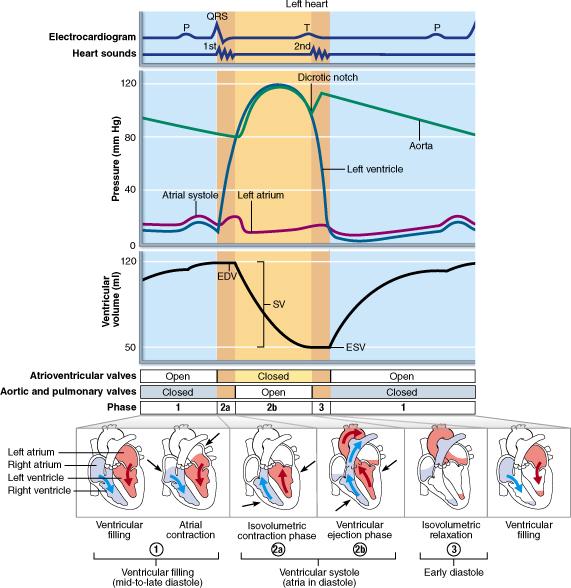
At what point in the cardiac cycle is pressure in the ventricles the highest (around 120 mm Hg)?
ventricular systole
mid-to-late diastole (ventricular filling)
mid-to-late diastole (atrial contraction)
early diastole (isovolumetric relaxation)
Ventricular systole
The left ventricular wall of the heart is thicker than the right wall in order to ________.
pump blood through a smaller valve
expand the thoracic cage during diastole
accommodate a greater volume of blood
pump blood with greater pressure
Pump blood with greater pressure
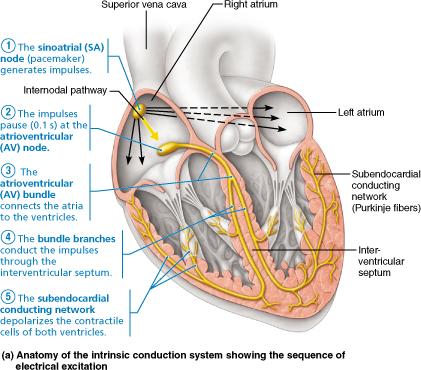
At what rate does the sinoatrial (SA) node ensure depolarization in the heart?
75 beats of the heart per minute
50 beats of the heart per minute
40 beats of the heart per minute
30 beats of the heart per minute
75 beats of the heart per minute
The heart's pacemaker is the __________.
Purkinje fibers
atrioventricular node
sinoatrial node
atrioventricular bundle
Sinoatrial node
The order of impulse conduction in the heart, from beginning to end, is __________.
SA node, bundle of His, AV node, bundle branches, and Purkinje fibers
SA node, AV node, bundle of His, bundle branches, and Purkinje fibers
SA node, bundle branches, bundle of His, AV node, and Purkinje fibers
SA node, bundle branches, AV node, bundle of His, and Purkinje fibers
SA node, AV node, bundle of His, and Purkinje fibers
True or False:
Auricles slightly increase blood volume in the ventricles.
False
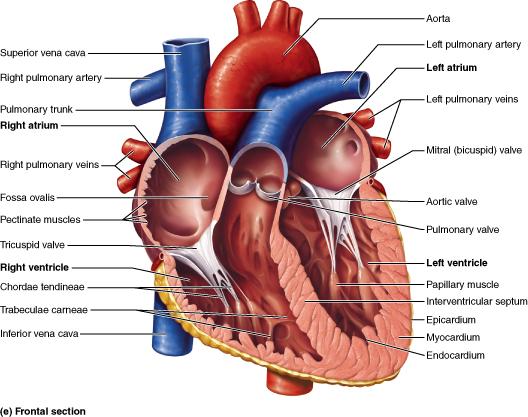
Into which chamber do the pulmonary veins send blood?
right atrium
right ventricle
left atrium
left ventricle
Left atrium
Which of the following terms refers to a lack of oxygen supply to heart muscle cells?
embolism
functional syncytium
infarction
ischemia
Ischemia
The term for pain associated with deficient blood delivery to the heart that may be caused by the transient spasm of coronary arteries is ________.
angina pectoris
myocardial infarct
pericarditis
ischemia
Angina pectoris
Which of the following does NOT deliver blood to the right atrium?
superior vena cava
coronary sinus
pulmonary veins
inferior vena cava
Pulmonary veins
What causes normal heart sounds?
pressure of blood in the ventricles
cardiac muscle contraction
opening of heart valves
heart valve closure
Heart valve closure
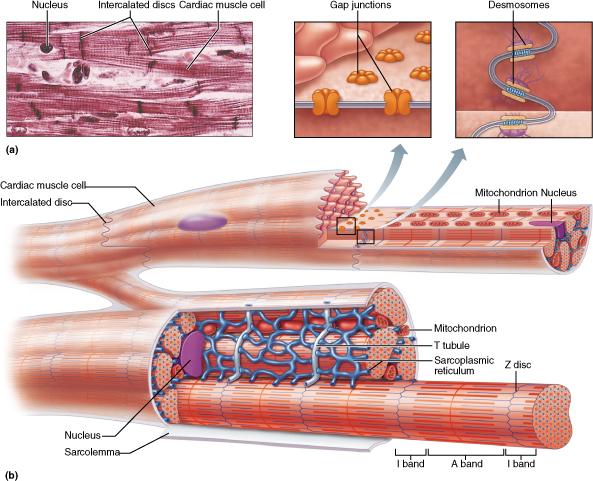
Consider the following characteristics of the cells found in muscle tissue. Which feature is shared by both cardiac muscle and skeletal muscle?
branched cells
triads
striations
intercalated discs
Striations
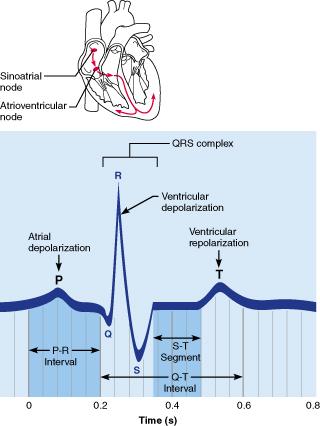
Which portion of the electrocardiogram represents the depolarization wave received from the sinoatrial (SA) node through the atria?
T wave
P wave
QRS complex
S-T segment
P wave
The QRS complex represents __________. Check all that apply.
atrial depolarization
ventricular repolarization
ventricular depolarization
atrial repolarization
Ventricular depolarization
Hemorrhage with a large loss of blood causes ________.
no change in blood pressure but a change in respiration
a lowering of blood pressure due to change in cardiac output
no change in blood pressure but a slower heart rate
a rise in blood pressure due to change in cardiac output
a lowering of blood pressure due to change in cardiac output
Select the correct statement about the heart valves.
The AV valves are supported by chordae tendineae so that regurgitation of blood into the atria during ventricular contraction does not occur.
The tricuspid valve divides the left atrium from the left ventricle.
The mitral valve separates the right atrium from the right ventricle.
Aortic and pulmonary valves control the flow of blood into the heart.
The AV valves are supported by chordae tendineae so that regurgitation of blood into the atria during ventricular contraction does not occur.
Which chamber of the heart has the highest probability of being the site of a myocardial infarction?
left atrium
right atrium
left ventricle
right ventricle
Left ventricle
The role of the coronary arteries is to __________.
direct blood to the pulmonary veins
move blood from the atria to the ventricles
supply blood to the heart tissue
direct blood to the aorta
Supply blood to the heart tissue
True or False:
The left side of the heart pumps the same volume of blood as the right.
True
The __________ valve is located between the right atrium and the right ventricle.
pulmonary semilunar
mitral
aortic semilunar
tricuspid
Tricuspid
Substances absorbed in the intestines would be routed to the liver via the __________.
inferior vena cava
hepatic portal vein
suprarenal veins
abdominal aorta
Hepatic portal vein
Which of the choices below explains why the arterioles are known as resistance vessels?
Their prime function is the exchange of nutrients and wastes between the blood and tissue cells.
They distribute blood to various parts of the body.
The contraction and relaxation of the smooth muscle in their walls can change their diameter.
They contain a large quantity of elastic tissue.
The contraction and relaxation of the smooth muscle in their walls can change their diameter.
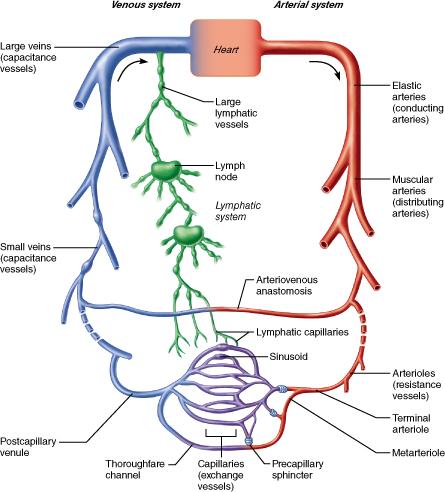
What type of vessel has relatively more smooth muscle and less elastic tissue?
elastic artery
arteriole
muscular artery
capillary
Muscular artery
Which of the following is NOT an important source of resistance to blood flow?
vessel length
vessel diameter
total blood volume
blood viscosity
Total blood volume
Permitting the exchange of nutrients and gases between the blood and tissue cells is the primary function of ________.
capillaries
arteries
arterioles
veins
Capillaries
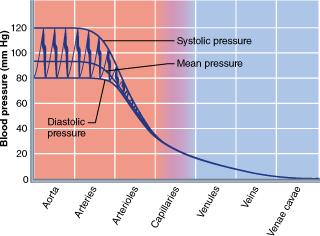
What blood vessel experiences the steepest drop in blood pressure?
capillaries
arterioles
venules
arteries
Arterioles
The aorta is an example of a(n) __________.
arteriole
elastic artery
vein
muscular artery
Elastic artery
What type of vessel has relatively little smooth muscle or elastin in the tunica media, a large lumen (average of 5.0 mm in diameter), and thin walls (average of 0.5 mm)?
venule
arteriole
vein
muscular artery
Vein
Aldosterone will ________.
result in a larger output of urine
decrease sodium reabsorption
promote an increase in blood pressure
promote a decrease in blood volume
Promote an increase in blood pressure
True or False:
A precapillary sphincter is a cuff of smooth muscle that regulates the flow of blood into the capillaries.
True
True or False:
The outermost layer of a blood vessel is the tunica intima.
False
What type of tissue is found in the walls of the arteries but not in the walls of capillaries and venules?
smooth muscle
collagen fibers
endothelium
elastic tissue
Elastic tissue
Which of the following will lower blood pressure?
atrial natriuretic peptide (ANP)
antidiuretic hormone (ADH)
aldosterone
angiotensin II
Atrial natriuretic peptide (ANP)
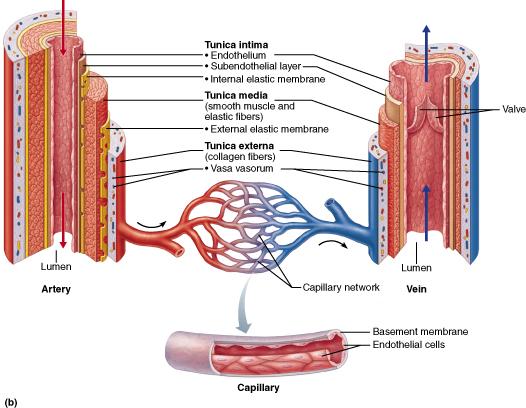
What layer can change blood vessel diameter by vasodilation and vasoconstriction?
tunica intima
vasa vasorum
tunica externa
tunica media
Tunica media
True or False:
Vasodilation is a widening of the lumen due to smooth muscle contraction.
False
Gas and nutrient exchanges between the blood and tissues take place at the __________.
veins
arteries
arterioles
capillaries
Capillaries
How would an attack by a mugger affect blood pressure? What is the physiological basis for your answer?
Blood pressure would decrease due to sympathetic nervous system stimulation.
Blood pressure would decrease due to parasympathetic nervous system stimulation.
Blood pressure would increase due to parasympathetic nervous system stimulation.
Blood pressure would increase due to vagal nerve stimulation.
Blood pressure would increase due to sympathetic nervous system stimulation.
Blood pressure would increase due to sympathetic nervous system stimulation.
Which statement best describes arteries?
All carry oxygenated blood to the heart.
All carry blood away from the heart.
All contain valves to prevent the backflow of blood.
Only large arteries are lined with endothelium.
All carry blood away from the heart.
Which of the following is a long-term mechanism for maintaining blood pressure?
baroceptor-initiated reflexes
hormonal control of peripheral resistance
chemoreceptor-initiated reflexes
renal regulation
Renal regulation
The baroreceptors in the carotid sinus and aortic arch are sensitive to which of the following?
changes in arterial pressure
an increase in oxygen levels
a decrease in oxygen levels
a decrease in carbon dioxide
Changes in arterial pressure
Factors that aid venous return include all except ________.
urinary output
activity of skeletal muscles
venous valves
pressure changes in the thorax
Urinary output
True and False:
Vasodilation will result in increased blood flow to a given tissue.
True
Which tunic of an artery is most responsible for maintaining blood pressure and continuous blood circulation?
tunica externa
tunica intima
tunica media
tunica adventitia
Tunica media
Leaky capillaries found in the bone marrow are called __________.
arterioles
fenestrated capillaries
continuous capillaries
sinusoidal capillaries
Sinusoidal capillaries
Which of the following is true about veins?
Veins carry blood away from the heart, while arteries carry blood to the heart.
Veins are more muscular than arteries.
Veins have valves; arteries do not.
Veins have a smaller diameter lumen than arteries.
Veins have valves; arteries do not
True or False:
An increase in blood viscosity will cause an increase in peripheral resistance.
True
Which of the following is true about veins?
Up to 35% of total body blood is in venous circulation at any given time.
Venous valves are formed from the tunica media.
Veins have a small lumen in relation to the thickness of the vessel wall.
Veins are called capacitance vessels or blood reservoirs.
Veins are called capacitance vessels or blood reservoirs.
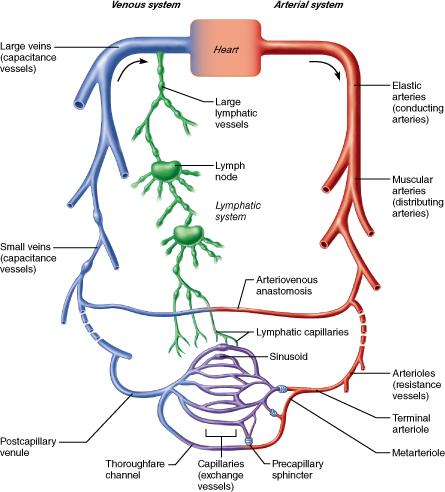
Which type of vessel contains elastin in all three tunics to allow the vessel to expand and recoil as the heart ejects blood?
muscular artery
arteriole
distributing artery
elastic artery
Elastic artery
The arteries that directly feed into the capillary beds are called ________.
venules
arterioles
muscular arteries
elastic arteries
Arterioles
Which of the following would experience a decreased blood flow during exercise?
skeletal muscles
skin
brain
kidneys
Kidneys
True or False:
Arteries supplying the same territory are often merged with one another, forming arterial anastomoses.
True
__________ is the pressure that propels blood to the tissues.
Mean arterial pressure
Diastolic pressure
Pulse pressure
Systolic pressure
Mean arterial pressure
True or False:
The thick-walled arteries close to the heart are called muscular arteries.
False
Why is it important that blood pressure drop to lower levels as it reaches the capillary beds?
Because capillaries are fragile and extremely permeable.
Because capillaries actually are high-pressure vessels.
Because capillaries actually need a higher blood pressure for filtration activities.
Because capillaries depend on the lower pressure to prevent fluid exchange between the capillaries and the tissue fluid.
Because capillaries are fragile and extremely permeable.
The inferior vena cava carries blood __________ the __________ of the heart.
away from;left atrium
to; right atrium
away from; right atrium
to: left atrium
To; right atrium
Which of the following chemicals does not help regulate blood pressure?
angiotensin II
atrial natriuretic peptide
nitric acid
ADH
Nitric acid
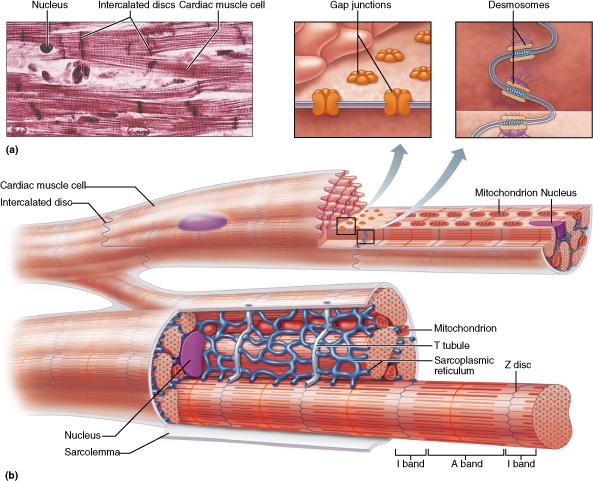
Which functional feature best describes the manner in which cardiac muscle contracts?
Nerve fibers must stimulate cardiac muscle cells for them to contract.
Only some motor units contract in cardiac muscle.
Automaticity (autorhythmicity) promotes the spontaneous contraction of the cardiac muscle cells.
Refractory periods in cardiac contractions are relatively short.
Automaticity (autorhythmicity) promotes the spontaneous contraction of the cardiac muscle cells.
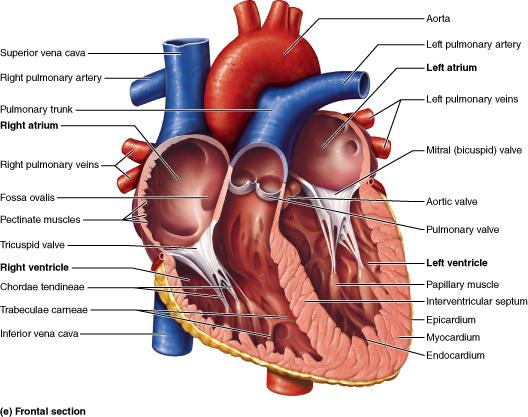
Into what vessel does the left ventricle eject blood?
superior vena cava
pulmonary veins
aorta
pulmonary trunk
Aorta
True or False:
Cardiac muscle has more mitochondria and depends less on a continual supply of oxygen than does skeletal muscle.
False
Which heart chamber sends deoxygenated blood to the lungs?
left atrium
right atrium
left ventricle
right ventricle
Right ventricle
True or False:
The myocardium receives its blood supply from the coronary arteries.
True
The heart has __________ chambers and __________ valves.
two; two
four; two
two; four
four; four
Four; four
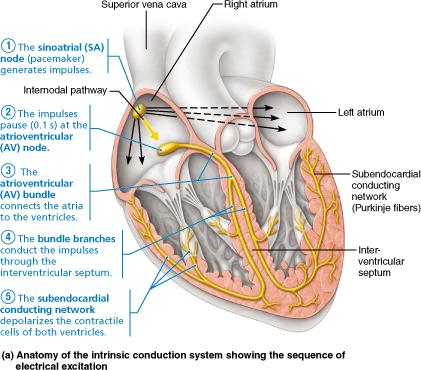
Specifically, what part of the intrinsic conduction system stimulates the atrioventricular (AV) node to conduct impulses to the atrioventricular bundle?
interventricular septum
subendocardial conducting network (Purkinje fibers)
bundle branches
sinoatrial (SA) node
Sinoatrial (SA) node
The first heart sound (the "lub" of the "lub-dup") is caused by __________.
closure of the semilunar valves
closure of the atrioventricular valves
opening of the semilunar valves
opening of the atrioventricular valves
Closure of the atrioventricular valves
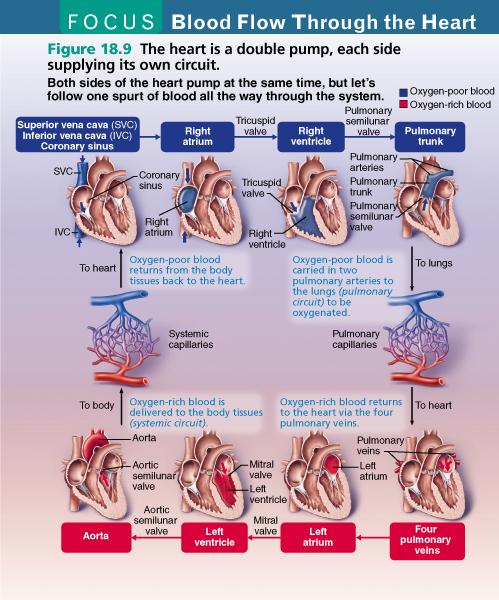
Into which chamber of the heart do the superior vena cava, inferior vena cava, and coronary sinus return deoxygenated blood?
left ventricle
left atrium
right atrium
right ventricle
Right atrium
Compared to skeletal muscle, cardiac muscle ________.
has more nuclei per cell
cells are larger than skeletal muscle
cells has gap junctions that allow it to act as a functional syncytium
lacks striations
has gap junctions that skeletal muscle cells
What structures connect the individual heart muscle cells?
chordae tendineae
trabaculae carneae
intercalated discs
anastomoses
intercalated discs
In a healthy individual which of the following would be low?
Afterload
stroke volume
contractility
preload
Afterload